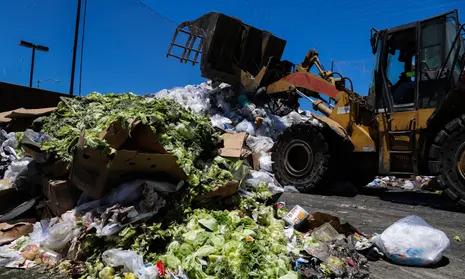Recycling of food waste in California is facing challenges in keeping pace

Two years after California initiated a program to divert organic waste from landfills, the state is significantly behind in implementing food recycling programs. It is widely acknowledged that the ambitious waste-reduction targets set for next year will not be met.
Organic waste, including food scraps and yard waste, emits methane, a potent greenhouse gas. California aims to prevent this waste from accumulating in landfills by converting it into compost or biogas. Individuals and businesses are expected to separate this material into a designated bin. However, changing people’s behavior in a short period has been challenging, and pandemic-related delays have hindered cities from establishing contracts for hauling organic waste. In Southern California, the nation’s largest facility for converting food waste into biogas has declared bankruptcy due to insufficient organic material.
Coby Skye, the recently retired deputy director for environmental services at Los Angeles County Public Works, stated, “We’re way behind on implementation.” He attributed this delay to Americans’ preference for convenience, making it challenging to educate them about waste separation. Some communities that have increased organic waste collection now have surplus compost, indicating further challenges as California progresses with its recycling plans.
Only a few states mandate organics recycling, and none have a program as extensive as California’s, which aims to reduce the amount of organic waste sent to landfills by 75% by 2025 compared to 2014 levels.
Experts say achieving that goal within a year would be difficult. Currently, about three-quarters of communities are collecting organic waste from homes, according to Rachel Machi Wagoner, director of CalRecycle. While some areas are lagging, the focus is on assisting them in getting started rather than penalizing them, as any progress helps the state move toward its emissions reduction goal.
Wagoner stated, “My goal is about figuring out where the challenges are and getting us as quickly as possible to success.” She added, “I don’t know when we will reach our 75% goal, but we will reach it.”
CalRecycle has not yet compiled data on how much organic waste was diverted from landfills in 2023. At the end of 2022, jurisdictions reported diverting 11.2 million tons (10.1 million metric tons) of organics, up from 9.9 million tons (8.9 million metric tons) the previous year, according to Wagoner.
Challenges include getting residents to sort their trash into a third bin and understanding what goes where. Other challenges involve determining what to do with the nutrient-rich compost once it is created from collected grass clippings, tree branches, and food scraps.
At Otay Landfill near the Mexican border, workers sort through piles of branches and leaves to remove plastic bits before the material is placed under tarps. The site processes 200 tons (181 metric tons) of organic waste daily and aims to double that amount as more cities increase collection, said Gabe Gonzales, the landfill’s operations manager.
California law requires cities to use much of the compost produced. However, many cities say they do not have enough space to utilize it all. Chula Vista, for example, is supposed to use 14,000 tons (12,700 metric tons) of compost a year but uses only a fraction of that amount, according to Manuel Medrano, the city’s environmental services manager.
Communities with more open space may have an easier time meeting these requirements. Cody Cain, head of marketing and sales for compost-maker Agromin, said his company has developed a plan to connect cities struggling to meet these requirements with farmers who need the material for their soil.
Food waste can also be converted into biogas to fuel vehicles or industrial operations. However, a large facility built in the Southern California city of Rialto is facing bankruptcy after Los Angeles was slow to increase collection, leaving the plant with insufficient waste, said Yaniv Scherson, chief operating officer for Anaergia Inc.
Heidi Sanborn, founding director of the environmental National Stewardship Action Council, supports the state’s law but wants more efforts to keep plastics out of compost and develop alternative energy solutions. She acknowledges that California’s challenges stem from attempting to build a system on a scale not seen in the country before.
“We’re trying to fix incredibly tough problems. We’re not going to find the perfect solution out of the gate,” Sanborn said. “But we’re on our way.”

